Mapping Irrigated Areas Based on Remotely Sensed Crop Phenology and Soil Moisture
Abstract
1. Introduction
2. Materials and Methods
2.1. The Case Study Area
2.2. Data
2.3. Methods
2.3.1. Irrigation Signals Extraction of Soil Water Based on MRS
2.3.2. Phenological Parameter Extraction Based on ORS Vegetation Index
2.3.3. Irrigation Mapping Based on Zoning and Multi-Source Remote Sensing Data Fusion
2.3.4. Precision Evaluation
3. Results
3.1. Irrigation Signals Extraction of Soil Water Based on MRS
3.2. Phenological Parameter Extraction Based on ORS Vegetation Index
3.3. Irrigation Mapping Based on Zoning and Multi-Source Remote Sensing Data Fusion
3.4. Precision Evaluation
4. Discussion
4.1. The Influence of Selection of Multi-Source MRS Soil Moisture Data on Irrigation Mapping
4.2. The Influence of NDVI Phenological Parameters and Zoning Scheme on Irrigation Mapping
4.3. Advantages and Other Limitations of Irrigation Mapping Based on Multi-Source Remote Sensing and Decision-Level Fusion
5. Conclusions
Author Contributions
Funding
Data Availability Statement
Conflicts of Interest
References
- Tsunekawa, A.; Liu, G.; Yamanaka, N.; Du, S. Restoration and Development of the Degraded Loess Plateau, China; Springer: Tokyo, Japan, 2014; pp. 93–108. [Google Scholar] [CrossRef]
- Liu, J.; Wiberg, D.; Zehnder, A.J.B.; Yang, H. Modeling the role of irrigation in winter wheat yield, crop water productivity, and production in china. Irrig. Sci. 2007, 26, 21–33. [Google Scholar] [CrossRef]
- Kumar, S.V.; Peters-Lidard, C.D.; Santanello, J.A.; Reichle, R.H.; Draper, C.S.; Koster, R.D.; Nearing, G.; Jasinski, M.F. Evaluating the utility of satellite soil moisture retrievals over irrigated areas and the ability of land data assimilation methods to correct for unmodeled processes. Hydrol. Earth Syst. Sci. 2015, 19, 4463–4478. [Google Scholar] [CrossRef]
- Massari, C.; Modanesi, S.; Dari, J.; Gruber, A.; De Lannoy, G.J.M.; Girotto, M.; Quintana-Segui, P.; Le Page, M.; Jarlan, L.; Zribi, M.; et al. A review of irrigation information retrievals from space and their utility for users. Remote Sens. 2021, 13, 4112. [Google Scholar] [CrossRef]
- Jalilvand, E.; Tajrishy, M.; Ghazi Zadeh Hashemi, S.A.; Brocca, L. Quantification of irrigation water using remote sensing of soil moisture in a semi-arid region. Remote Sens. Environ. 2019, 231, 111226. [Google Scholar] [CrossRef]
- Zajac, Z.; Gomez, O.; Gelati, E.; van der Velde, M.; Bassu, S.; Ceglar, A.; Chukaliev, O.; Panarello, L.; Koeble, R.; van den Berg, M.; et al. Estimation of spatial distribution of irrigated crop areas in europe for large-scale modelling applications. Agric. Water Manag. 2022, 266, 107527. [Google Scholar] [CrossRef]
- Siebert, S.; Doll, P.; Hoogeveen, J.; Faures, J.M.; Frenken, K.; Feick, S. Development and validation of the global map of irrigation areas. Hydrol. Earth Syst. Sci. 2005, 9, 535–547. [Google Scholar] [CrossRef]
- Liu, Y.; Wu, W.; Li, H.; Imtiaz, M.; Li, Z.; Zhou, Q. Intercomparison on four irrigated cropland maps in mainland China. Sensors 2018, 18, 1197. [Google Scholar] [CrossRef]
- Shahriar Pervez, M.; Budde, M.; Rowland, J. Mapping irrigated areas in afghanistan over the past decade using modis ndvi. Remote Sens. Environ. 2014, 149, 155–165. [Google Scholar] [CrossRef]
- Jin, N.; Tao, B.; Ren, W.; Feng, M.; Sun, R.; He, L.; Zhuang, W.; Yu, Q. Mapping irrigated and rainfed wheat areas using multi-temporal satellite data. Remote Sens. 2016, 8, 207. [Google Scholar] [CrossRef]
- Ozdogan, M.; Rodell, M.; Beaudoing, H.K.; Toll, D.L. Simulating the effects of irrigation over the united states in a land surface model based on satellite-derived agricultural data. J. Hydrometeorol. 2010, 11, 171–184. [Google Scholar] [CrossRef]
- Dari, J.; Quintana-Seguí, P.; Escorihuela, M.J.; Stefan, V.; Brocca, L.; Morbidelli, R. Detecting and mapping irrigated areas in a mediterranean environment by using remote sensing soil moisture and a land surface model. J. Hydrol. 2021, 596, 126129. [Google Scholar] [CrossRef]
- Portmann, F.T.; Siebert, S.; Döll, P. Mirca2000-global monthly irrigated and rainfed crop areas around the year 2000: A new high-resolution data set for agricultural and hydrological modeling. Glob. Biogeochem. Cycles 2010, 24. [Google Scholar] [CrossRef]
- Ozdogan, M.; Gutman, G. A new methodology to map irrigated areas using multi-temporal modis and ancillary data: An application example in the continental us. Remote Sens. Environ. 2008, 112, 3520–3537. [Google Scholar] [CrossRef]
- Ide, A.K.; Baptista, G.M.d.M. Modis time series for irrigated-area mapping in hydrographic basins of the brazilian northeastern region. Pesqui. Agropecuária Bras. 2018, 53, 80–89. [Google Scholar] [CrossRef]
- Xie, Y.; Gibbs, H.K.; Lark, T.J. Landsat-based irrigation dataset (lanid): 30-m resolution maps of irrigation distribution, frequency, and change for the u.S., 1997-2017. Earth Syst. Sci. Data 2021, 13, 5689–5710. [Google Scholar] [CrossRef]
- Zhang, L.; Zhang, K.; Zhu, X.; Chen, H.; Wang, W. Integrating remote sensing, irrigation suitability and statistical data for irrigated cropland mapping over mainland china. J. Hydrol. 2022, 613, 128413. [Google Scholar] [CrossRef]
- Thenkabail, P.S.; Biradar, C.M.; Noojipady, P.; Dheeravath, V.; Li, Y.J.; Velpuri, M.; Gumma, M.; Gangalakunta, O.R.P.; Turral, H.; Cai, X.L.; et al. Global irrigated area map (giam), derived from remote sensing, for the end of the last millennium. Int. J. Remote Sens. 2009, 30, 3679–3733. [Google Scholar] [CrossRef]
- Salmon, J.M.; Friedl, M.A.; Frolking, S.; Wisser, D.; Douglas, E.M. Global rain-fed, irrigated, and paddy croplands: A new high resolution map derived from remote sensing, crop inventories and climate data. Int. J. Appl. Earth Obs. Geoinf. 2015, 38, 321–334. [Google Scholar] [CrossRef]
- Teluguntla, P.; Thenkabail, P.S.; Xiong, J.; Gumma, M.K.; Giri, C.; Milesi, C.; Ozdogan, M.; Congalton, R.; Tilton, J.; Sankey, T. Nasa Making Earth System Data Records for Use in Research Environments (Measures) Global Food Security Support Analysis Data (Gfsad) Crop Mask 2010 Global 1 km v001; NASA: Washington, DC, USA, 2016.
- Meier, J.; Zabel, F.; Mauser, W. A global approach to estimate irrigated areas—A comparison between different data and statistics. Hydrol. Earth Syst. Sci. Discuss. 2018, 22, 1119–1133. [Google Scholar] [CrossRef]
- Ambika, A.K.; Wardlow, B.; Mishra, V. Remotely sensed high resolution irrigated area mapping in india for 2000 to 2015. Sci. Data 2016, 3, 160118. [Google Scholar] [CrossRef]
- Zhu, X.; Zhu, W.; Zhang, J.; Pan, Y. Mapping irrigated areas in china from remote sensing and statistical data. IEEE J. Sel. Top. Appl. Earth Obs. Remote Sens. 2014, 7, 4490–4504. [Google Scholar] [CrossRef]
- Xiang, K.L.; Yuan, W.P.; Wang, L.W.; Deng, Y.J. An lswi-based method for mapping irrigated areas in china using moderate-resolution satellite data. Remote Sens. 2020, 12, 4181. [Google Scholar] [CrossRef]
- Zhang, C.; Dong, J.; Ge, Q. Mapping 20 years of irrigated croplands in china using modis and statistics and existing irrigation products. Sci. Data 2022, 9, 407. [Google Scholar] [CrossRef] [PubMed]
- Peña-Arancibia, J.L.; McVicar, T.R.; Paydar, Z.; Li, L.; Guerschman, J.P.; Donohue, R.J.; Dutta, D.; Podger, G.M.; van Dijk, A.I.J.M.; Chiew, F.H.S. Dynamic identification of summer cropping irrigated areas in a large basin experiencing extreme climatic variability. Remote Sens. Environ. 2014, 154, 139–152. [Google Scholar] [CrossRef]
- Pun, M.; Mutiibwa, D.; Li, R. Land use classification: A surface energy balance and vegetation index application to map and monitor irrigated lands. Remote Sens. 2017, 9, 1256. [Google Scholar] [CrossRef]
- Kaur, S.; Bansal, R.K.; Mittal, M.; Goyal, L.M.; Kaur, I.; Verma, A.; Son, L.H. Mixed pixel decomposition based on extended fuzzy clustering for single spectral value remote sensing images. J. Indian Soc. Remote Sens. 2019, 47, 427–437. [Google Scholar] [CrossRef]
- Brocca, L.; Tarpanelli, A.; Filippucci, P.; Dorigo, W.; Zaussinger, F.; Gruber, A.; Fernández-Prieto, D. How much water is used for irrigation? A new approach exploiting coarse resolution satellite soil moisture products. Int. J. Appl. Earth Obs. Geoinf. 2018, 73, 752–766. [Google Scholar] [CrossRef]
- Zaussinger, F.; Dorigo, W.; Gruber, A.; Tarpanelli, A.; Filippucci, P.; Brocca, L. Estimating irrigation water use over the contiguous united states by combining satellite and reanalysis soil moisture data. Hydrol. Earth Syst. Sci. 2019, 23, 897–923. [Google Scholar] [CrossRef]
- Zhu, L.; Zhu, A.X. Extraction of irrigation signals by using smap soil moisture data. Remote Sens. 2021, 13, 2142. [Google Scholar] [CrossRef]
- Singh, R.P.; Dubey, A.K.; Pradhan, R.; Gupta, P.K.; Singh, D. Discerning shifting irrigation practices from passive microwave radiometry over punjab and haryana. J. Water Clim. Chang. 2017, 8, 303–319. [Google Scholar] [CrossRef]
- Lawston, P.M.; Santanello, J.A.; Kumar, S.V. Irrigation signals detected from smap soil moisture retrievals. Geophys. Res. Lett. 2017, 44, 11860–11867. [Google Scholar] [CrossRef]
- Zohaib, M.; Choi, M. Satellite-based global-scale irrigation water use and its contemporary trends. Sci. Total Environ. 2020, 714, 136719. [Google Scholar] [CrossRef] [PubMed]
- Zohaib, M.; Kim, H.; Choi, M. Detecting global irrigated areas by using satellite and reanalysis products. Sci. Total Environ. 2019, 677, 679–691. [Google Scholar] [CrossRef] [PubMed]
- Zhang, X.H.; Qiu, J.X.; Leng, G.Y.; Yang, Y.M.; Gao, Q.Z.; Fan, Y.; Luo, J.S. The potential utility of satellite soil moisture retrievals for detecting irrigation patterns in china. Water 2018, 10, 1505. [Google Scholar] [CrossRef]
- Zhang, H.; Wang, X.; You, M.; Liu, C. Water-yield relations and water-use efficiency of winter wheat in the north china plain. Irrig. Sci. 1999, 19, 37–45. [Google Scholar] [CrossRef]
- Xu, H.; Zhang, X.H.; Ye, Z.; Jiang, L.; Qiu, X.L.; Tian, Y.C.; Zhu, Y.; Cao, W.X. Machine learning approaches can reduce environmental data requirements for regional yield potential simulation. Eur. J. Agron. 2021, 129, 126335. [Google Scholar] [CrossRef]
- Siebert, S.; Henrich, V.; Frenken, K.; Burke, J. Update of the Digital Global Map of Irrigation Areas to Version 5; Institute of Crop Science and Resource Conservation, Rheinische Friedrich-Wilhelms-Universität Bonn: Bonn, Germany, 2013. [Google Scholar]
- Wagner, W.; Lemoine, G.; Rott, H. A method for estimating soil moisture from ers scatterometer and soil data. Remote Sens. Environ. 1999, 70, 191–207. [Google Scholar] [CrossRef]
- Liu, Y.Y.; Parinussa, R.M.; Dorigo, W.A.; De Jeu, R.A.M.; Wagner, W.; van Dijk, A.I.J.M.; McCabe, M.F.; Evans, J.P. Developing an improved soil moisture dataset by blending passive and active microwave satellite-based retrievals. Hydrol. Earth Syst. Sci. 2011, 15, 425–436. [Google Scholar] [CrossRef]
- Liu, Y.Y.; Dorigo, W.A.; Parinussa, R.M.; de Jeu, R.A.M.; Wagner, W.; McCabe, M.F.; Evans, J.P.; van Dijk, A.I.J.M. Trend-preserving blending of passive and active microwave soil moisture retrievals. Remote Sens. Environ. 2012, 123, 280–297. [Google Scholar] [CrossRef]
- Pervez, M.S.; Brown, J.F. Mapping irrigated lands at 250-m scale by merging modis data and national agricultural statistics. Remote Sens. 2010, 2, 2388–2412. [Google Scholar] [CrossRef]
- Herbert, C.; Pablos, M.; Vall-llossera, M.; Camps, A.; Martínez-Fernández, J. Analyzing spatio-temporal factors to estimate the response time between smos and in-situ soil moisture at different depths. Remote Sens. 2020, 12, 2614. [Google Scholar] [CrossRef]
- Ozdogan, M.; Yang, Y.; Allez, G.; Cervantes, C. Remote sensing of irrigated agriculture: Opportunities and challenges. Remote Sens. 2010, 2, 2274–2304. [Google Scholar] [CrossRef]
- Chen, J.; Jönsson, P.; Tamura, M.; Gu, Z.; Matsushita, B.; Eklundh, L. A simple method for reconstructing a high-quality ndvi time-series data set based on the savitzky–golay filter. Remote Sens. Environ. 2004, 91, 332–344. [Google Scholar] [CrossRef]
- Jönsson, P.; Eklundh, L. Timesat—A program for analyzing time-series of satellite sensor data. Comput. Geosci. 2004, 30, 833–845. [Google Scholar] [CrossRef]
- Eklundha, L.; Jönssonb, P. TIMESAT 3.3 Software Manual; Lund University: Lund, Sweden, 2016. [Google Scholar]
- Reed, B.C.; Brown, J.F.; VanderZee, D.; Loveland, T.R.; Merchant, J.W.; Ohlen, D.O. Measuring phenological variability from satellite imagery. J. Veg. Sci. 1994, 5, 703–714. [Google Scholar] [CrossRef]
- Biggs, T.W.; Thenkabail, P.S.; Gumma, M.K.; Scott, C.A.; Parthasaradhi, G.R.; Turral, H.N. Irrigated area mapping in heterogeneous landscapes with modis time series, ground truth and census data, krishna basin, India. Int. J. Remote Sens. 2006, 27, 4245–4266. [Google Scholar] [CrossRef]
- Abou El-Magd, I.; Tanton, T.W. Improvements in land use mapping for irrigated agriculture from satellite sensor data using a multi-stage maximum likelihood classification. Int. J. Remote Sens. 2003, 24, 4197–4206. [Google Scholar] [CrossRef]
- Otukei, J.R.; Blaschke, T. Land cover change assessment using decision trees, support vector machines and maximum likelihood classification algorithms. Int. J. Appl. Earth Obs. Geoinf. 2010, 12, S27–S31. [Google Scholar] [CrossRef]
- Shen, J.G.; Zhang, C.; Zheng, Y.; Wang, R.X. Decision-level fusion with a pluginable importance factor generator for remote sensing image scene classification. Remote Sens. 2021, 13, 3579. [Google Scholar]
- Zhang, D.; Li, R.; Batchelor, W.D.; Ju, H.; Li, Y. Evaluation of limited irrigation strategies to improve water use efficiency and wheat yield in the north china plain. PLoS ONE 2018, 13, e0189989. [Google Scholar] [CrossRef]
- Guo, D.; Olesen, J.E.; Manevski, K.; Ma, X. Optimizing irrigation schedule in a large agricultural region under different hydrologic scenarios. Agric. Water Manag. 2021, 245, 106575. [Google Scholar] [CrossRef]
- Tuinenburg, O.A.; de Vries, J.P.R. Irrigation patterns resemble era-interim reanalysis soil moisture additions. Geophys. Res. Lett. 2017, 44, 10341–10348. [Google Scholar] [CrossRef]
- Rötzer, K.; Montzka, C.; Vereecken, H. Spatio-temporal variability of global soil moisture products. J. Hydrol. 2015, 522, 187–202. [Google Scholar] [CrossRef]
- Luo, M.; Meng, F.; Sa, C.; Duan, Y.; Bao, Y.; Liu, T.; De Maeyer, P. Response of vegetation phenology to soil moisture dynamics in the mongolian plateau. Catena 2021, 206, 105505. [Google Scholar] [CrossRef]
- Zhang, T.T.; Qi, J.G.; Gao, Y.; Ouyang, Z.T.; Zeng, S.L.; Zhao, B. Detecting soil salinity with modis time series vi data. Ecol. Indic. 2015, 52, 480–489. [Google Scholar] [CrossRef]
- Srivastava, S.K.; Jayaraman, V.; Nageswara Rao, P.P.; Manikiam, B.; Chandrasekhar, M.G. Interlinkages of noaa/avhrr derived integrated ndvi to seasonal precipitation and transpiration in dryland tropics. Int. J. Remote Sens. 1997, 18, 2931–2952. [Google Scholar] [CrossRef]
- Carlson, T.N.; Ripley, D.A. On the relation between ndvi, fractional vegetation cover, and leaf area index. Remote Sens. Environ. 1997, 62, 241–252. [Google Scholar] [CrossRef]
- Ragettli, S.; Herberz, T.; Siegfried, T. An unsupervised classification algorithm for multi-temporal irrigated area mapping in central asia. Remote Sens. 2018, 10, 1823. [Google Scholar] [CrossRef]
- Bartholomé, E.; Belward, A.S. Glc2000: A new approach to global land cover mapping from earth observation data. Int. J. Remote Sens. 2007, 26, 1959–1977. [Google Scholar] [CrossRef]
- Zurqani, H.A.; Allen, J.S.; Post, C.J.; Pellett, C.A.; Walker, T.C. Mapping and quantifying agricultural irrigation in heterogeneous landscapes using google earth engine. Remote Sens. Appl. Soc. Environ. 2021, 23, 100590. [Google Scholar] [CrossRef]
- Zheng, B.; Myint, S.W.; Thenkabail, P.S.; Aggarwal, R.M. A support vector machine to identify irrigated crop types using time-series landsat ndvi data. Int. J. Appl. Earth Obs. Geoinf. 2015, 34, 103–112. [Google Scholar] [CrossRef]
- Gumma, M.K.; Thenkabail, P.S.; Hideto, F.; Nelson, A.; Dheeravath, V.; Busia, D.; Rala, A. Mapping irrigated areas of ghana using fusion of 30 m and 250 m resolution remote-sensing data. Remote Sens. 2011, 3, 816–835. [Google Scholar] [CrossRef]
- Cai, H.; Wang, Y.; Lin, Y.; Li, S.; Wang, M.; Teng, F. Systematic comparison of objects classification methods based on als and optical remote sensing images in urban areas. Electronics 2022, 11, 3041. [Google Scholar] [CrossRef]
- Ferrant, S.; Selles, A.; Le Page, M.; Herrault, P.-A.; Pelletier, C.; Al-Bitar, A.; Mermoz, S.; Gascoin, S.; Bouvet, A.; Saqalli, M.; et al. Detection of irrigated crops from sentinel-1 and sentinel-2 data to estimate seasonal groundwater use in south india. Remote Sens. 2017, 9, 1119. [Google Scholar] [CrossRef]
- Pageot, Y.; Baup, F.; Inglada, J.; Baghdadi, N.; Demarez, V. Detection of irrigated and rainfed crops in temperate areas using sentinel-1 and sentinel-2 time series. Remote Sens. 2020, 12, 3044. [Google Scholar] [CrossRef]
- Bazzi, H.; Baghdadi, N.; Fayad, I.; Zribi, M.; Belhouchette, H.; Demarez, V. Near real-time irrigation detection at plot scale using sentinel-1 data. Remote Sens. 2020, 12, 1456. [Google Scholar] [CrossRef]
- Ding, J.F.; Liang, P.; Wu, P.; Zhu, M.; Li, C.Y.; Zhu, X.K.; Gao, D.R.; Chen, Y.L.; Guo, W.S. Effects of waterlogging on grain yield and associated traits of historic wheat cultivars in the middle and lower reaches of the yangtze river, china. Field Crops Res. 2020, 246, 107695. [Google Scholar] [CrossRef]
- Romaguera, M.; Hoekstra, A.Y.; Su, Z.; Krol, M.S.; Salama, M.S. Potential of using remote sensing techniques for global assessment of water footprint of crops. Remote Sens. 2010, 2, 1177–1196. [Google Scholar] [CrossRef]
- Hao, Z.; Zhao, H.L.; Zhang, C.; Wang, H.; Jiang, Y.Z. Detecting winter wheat irrigation signals using smap gridded soil moisture data. Remote Sens. 2019, 11, 2390. [Google Scholar] [CrossRef]
- Aboelsoud, H.M.; Habib, A.; Engel, B.; Hashem, A.A.; El-Hassan, W.A.; Govind, A.; Elnashar, A.; Eid, M.; Kheir, A.M.S. The combined impact of shallow groundwater and soil salinity on evapotranspiration using remote sensing in an agricultural alluvial setting. J. Hydrol. Reg. Stud. 2023, 47, 101372. [Google Scholar] [CrossRef]
- Pan, Y.; Zhang, C.; Gong, H.; Yeh, P.J.F.; Shen, Y.; Guo, Y.; Huang, Z.; Li, X. Detection of human-induced evapotranspiration using grace satellite observations in the haihe river basin of china. Geophys. Res. Lett. 2017, 44, 190–199. [Google Scholar] [CrossRef]
- van Eekelen, M.W.; Bastiaanssen, W.G.M.; Jarmain, C.; Jackson, B.; Ferreira, F.; van der Zaag, P.; Saraiva Okello, A.; Bosch, J.; Dye, P.; Bastidas-Obando, E.; et al. A novel approach to estimate direct and indirect water withdrawals from satellite measurements: A case study from the incomati basin. Agric. Ecosyst. Environ. 2015, 200, 126–142. [Google Scholar] [CrossRef]
- Attia, A.; Qureshi, A.S.; Kane, A.M.; Alikhanov, B.; Kheir, A.M.S.; Ullah, H.; Datta, A.; Samasse, K. Selection of potential sites for promoting small-scale irrigation across mali using remote sensing and gis. Sustainability 2022, 14, 12040. [Google Scholar] [CrossRef]


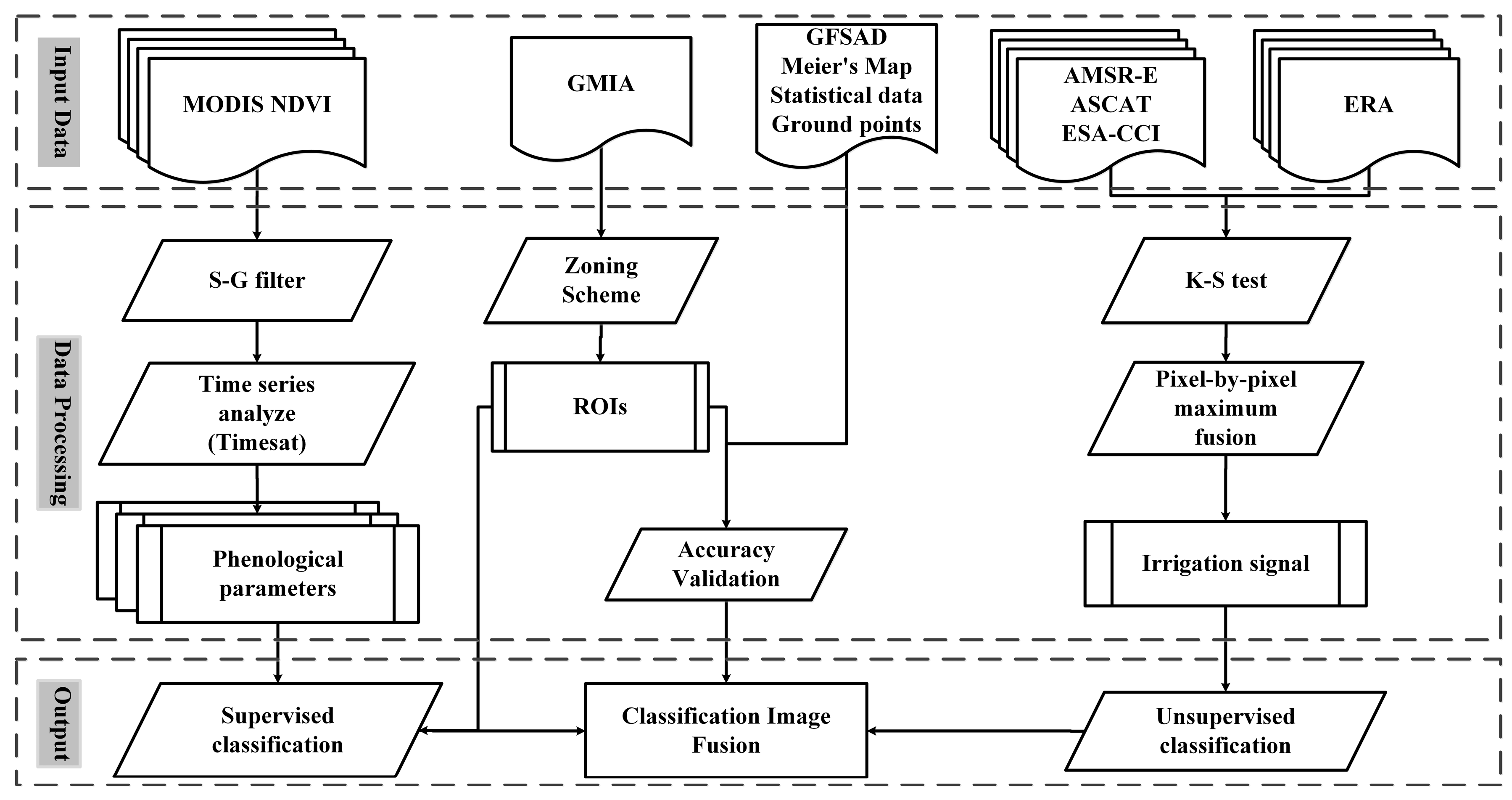

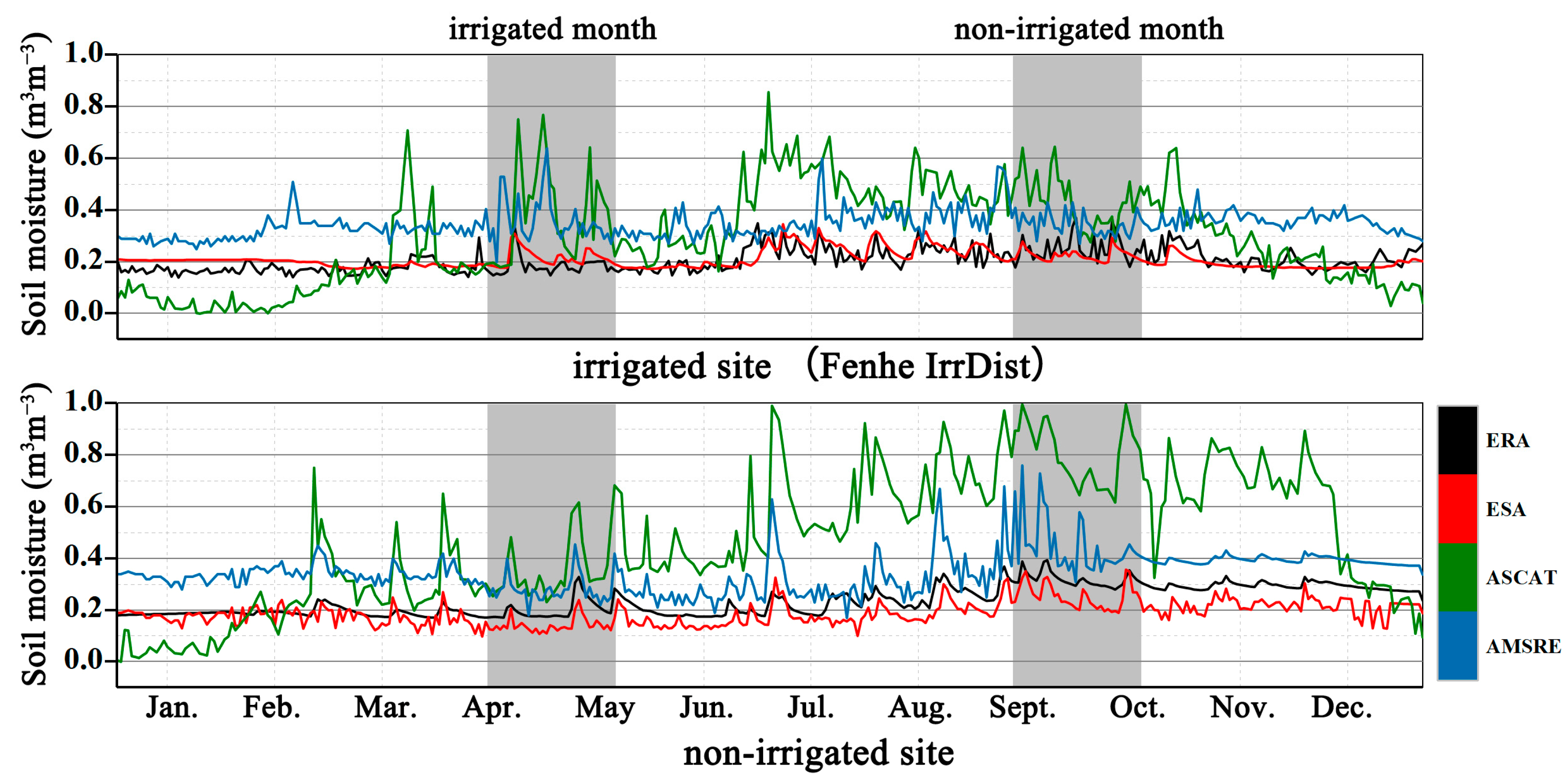
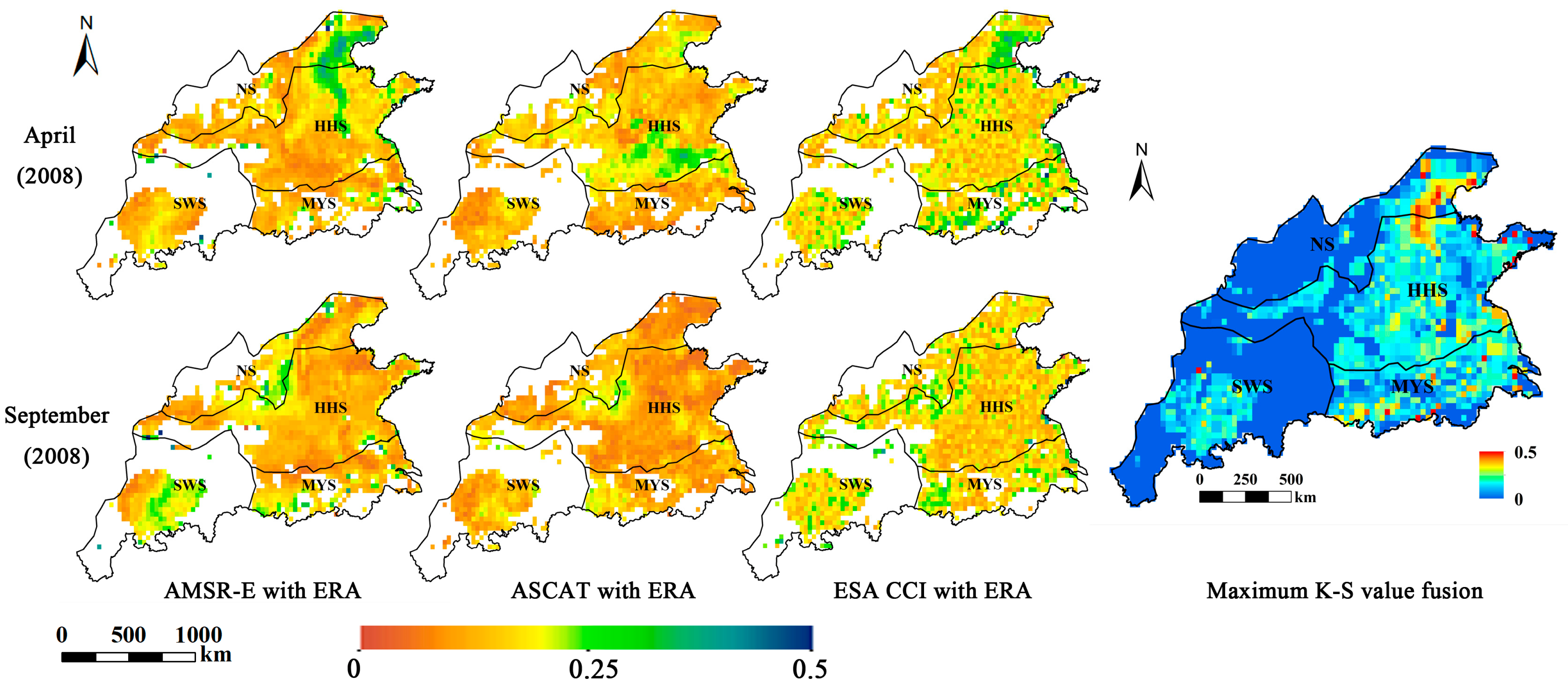
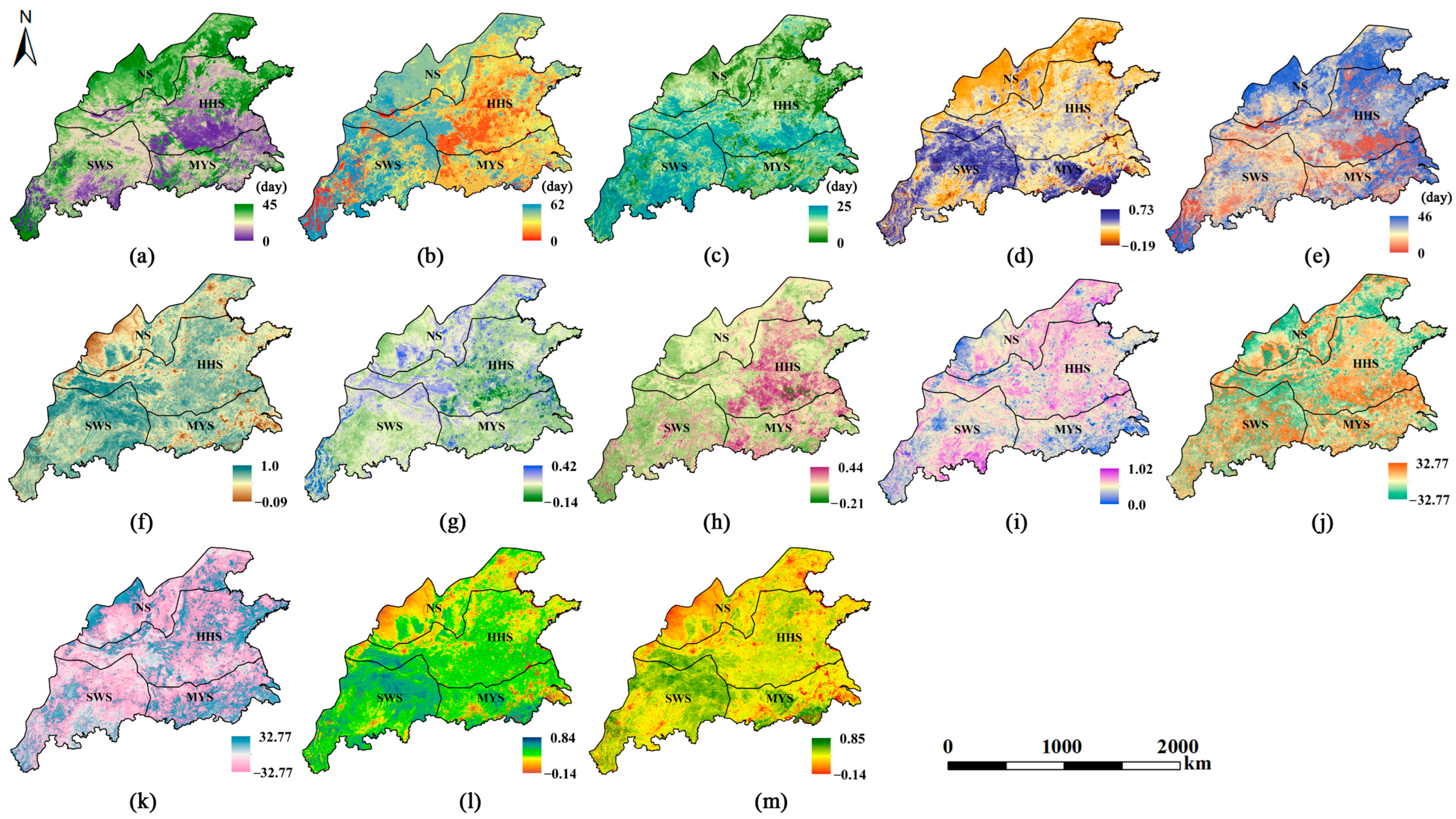


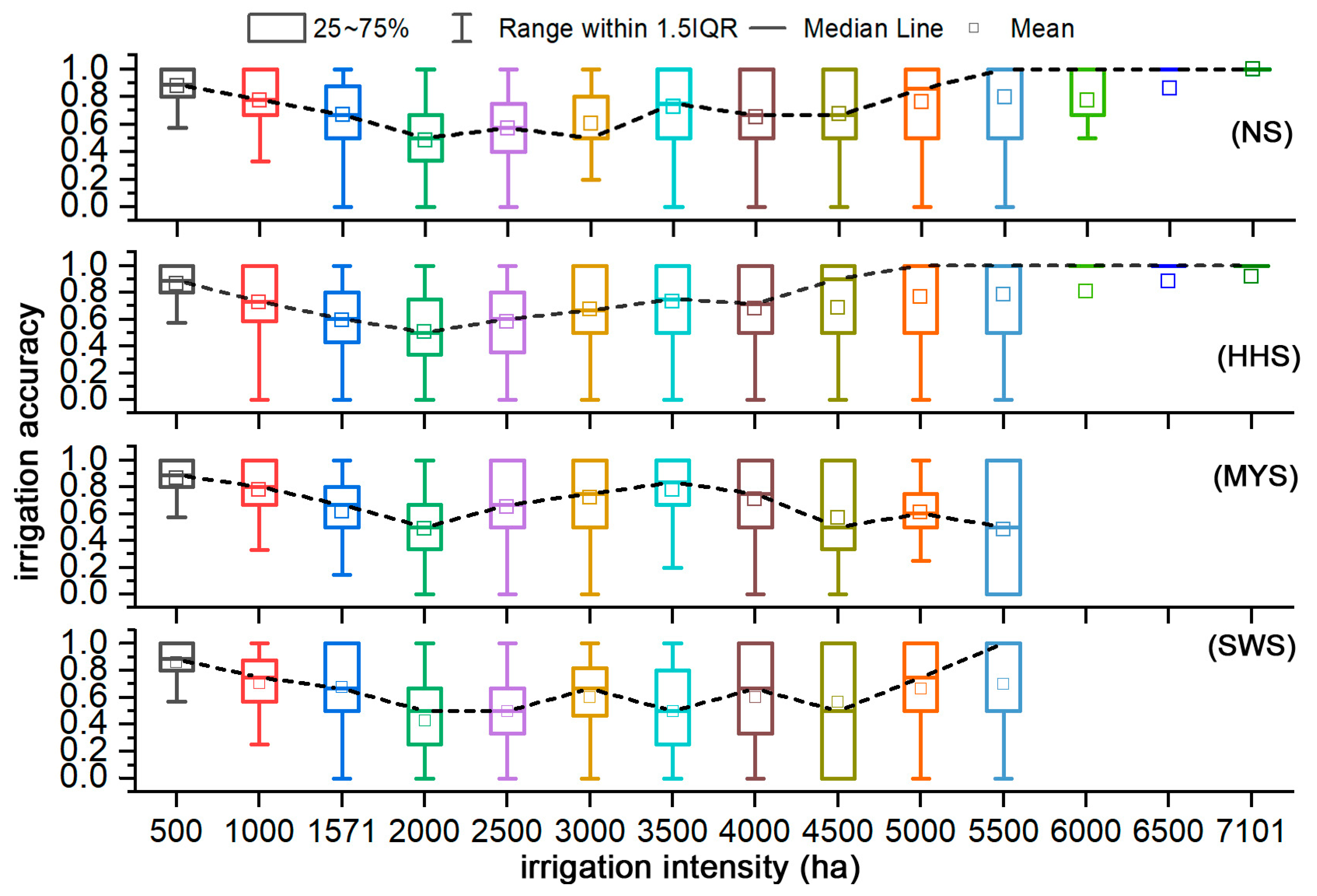
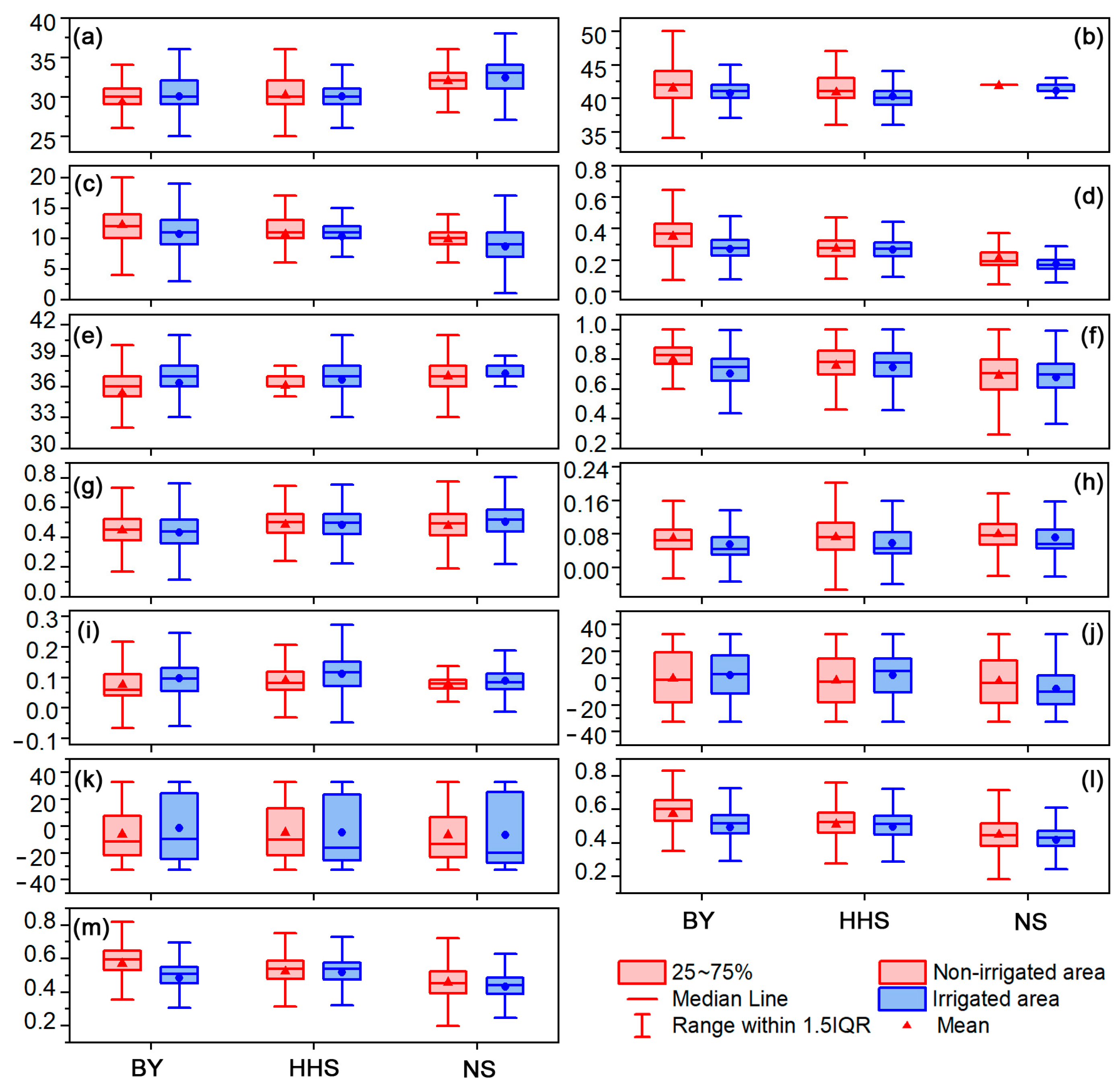
| Research Data | Year | Description | Resolution | Resource |
|---|---|---|---|---|
| ASCAT [40,41], AMSR-E [41], ESA CCI [42] | 2000–2008 | 0–2.5 cm volume of water content | 0.25° | ftp://hydro1.sci.gsfc.nasa.gov/data/s4pa/ accessed on 25 October 2021 |
| ERA-Interim | 2000–2008 | 0–7 cm volume water content | 0.25° | https://cds.climate.copernicus.eu/ accessed on 25 October 2021 |
| MOD13A2 | 2007–2010 | 16d-NDVI | 1 km | Google Earth engine |
| GMIA 5.0 [39] | 2000–2008 | irrigation intensity | 5′ | FAOSTAT accessed on 25 October 2021 |
| GRIPC [19] | 2005 | irrigation intensity | 5′ | https://ftp-earth.bu.edu/public/friedl/GRIPCmap/ accessed on 30 October 2021 |
| GIAM [18] | 2000 | irrigated area | 10 km | http://waterdata.iwmi.org accessed on 7 November 2021 |
| GFSAD [20] | 2007–2012 | irrigated area | 1 km | Google Earth engine |
| Meier’s Map [21] | 1999–2012 | irrigated area | 30′′ | https://doi.pangaea.de/10.1594/PANGAEA.884744 accessed on 20 May 2022 |
| CIrrMap [17] | 2000 | irrigated area | 250 m | https://doi.org/10.6084/m9.figshare.17056442.v2 accessed on 20 May 2022 |
| NS | HHS | SWS | MYS | |
|---|---|---|---|---|
| Top Quartile | 4492 | 4479 | 2630 | 3498 |
| Min | 1573 | 1572 | 1572 | 1573 |
| Max | 6562 | 7101 | 5324 | 5331 |
| Mean | 3527 | 3512 | 2378 | 2951 |
| Median | 20 | 1768 | 210 | 2148 |
| STD | 1562 | 1811 | 803 | 1289 |
| Products | NS | HHS | SWS | MYS | |
|---|---|---|---|---|---|
| This study | MRS-based map | 42.1% | 72.7% | 29.1% | 76.4% |
| ORS-based map | 31.8% | 74.0% | 28.2% | 78.8% | |
| DL fused map at ORS resolution | 21.3% | 50.8% | 8.2% | 56.6% | |
| DL fused map at MRS resolution | 21.9% | 52.7% | 8.1% | 56.6% | |
| GFSAD | 24.5% | 56.6% | 9.0% | 12.5% | |
| Meier’s Map | 16.4% | 42.6% | 7.9% | 27.2% | |
| . | Meier’s Map | GFSAD | DL-Fusion (ORS) | DL-Fusion (MRS) |
|---|---|---|---|---|
| OA | 69.51% | 68.67% | 73.49% | 67.07% |
| PA (irrigation) | 56.76% | 57.89% | 71.05% | 68.42% |
| PA (non-irrigation) | 80% | 77.78% | 75.56% | 65.91% |
| UA (irrigation) | 70% | 68.75% | 71.05% | 63.41% |
| UA (non-irrigation) | 69.23% | 68.63% | 75.56% | 70.73% |
Disclaimer/Publisher’s Note: The statements, opinions and data contained in all publications are solely those of the individual author(s) and contributor(s) and not of MDPI and/or the editor(s). MDPI and/or the editor(s) disclaim responsibility for any injury to people or property resulting from any ideas, methods, instructions or products referred to in the content. |
© 2023 by the authors. Licensee MDPI, Basel, Switzerland. This article is an open access article distributed under the terms and conditions of the Creative Commons Attribution (CC BY) license (https://creativecommons.org/licenses/by/4.0/).
Share and Cite
Zuo, W.; Mao, J.; Lu, J.; Zheng, Z.; Han, Q.; Xue, R.; Tian, Y.; Zhu, Y.; Cao, W.; Zhang, X. Mapping Irrigated Areas Based on Remotely Sensed Crop Phenology and Soil Moisture. Agronomy 2023, 13, 1556. https://doi.org/10.3390/agronomy13061556
Zuo W, Mao J, Lu J, Zheng Z, Han Q, Xue R, Tian Y, Zhu Y, Cao W, Zhang X. Mapping Irrigated Areas Based on Remotely Sensed Crop Phenology and Soil Moisture. Agronomy. 2023; 13(6):1556. https://doi.org/10.3390/agronomy13061556
Chicago/Turabian StyleZuo, Wenjun, Jingjing Mao, Jiaqi Lu, Zhaowen Zheng, Qin Han, Runjia Xue, Yongchao Tian, Yan Zhu, Weixing Cao, and Xiaohu Zhang. 2023. "Mapping Irrigated Areas Based on Remotely Sensed Crop Phenology and Soil Moisture" Agronomy 13, no. 6: 1556. https://doi.org/10.3390/agronomy13061556
APA StyleZuo, W., Mao, J., Lu, J., Zheng, Z., Han, Q., Xue, R., Tian, Y., Zhu, Y., Cao, W., & Zhang, X. (2023). Mapping Irrigated Areas Based on Remotely Sensed Crop Phenology and Soil Moisture. Agronomy, 13(6), 1556. https://doi.org/10.3390/agronomy13061556








